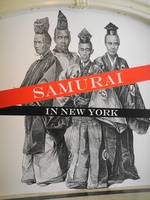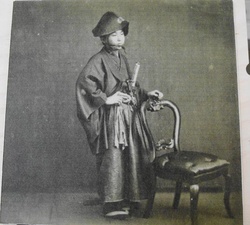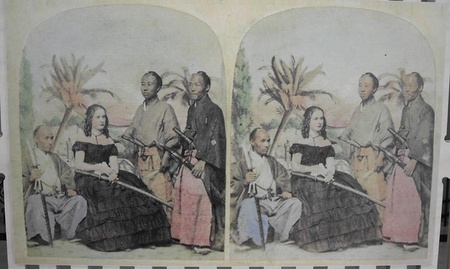There is a curious gem of an exhibition on now at the Museum of the City of New York, Samurai in New York. The show tells the story of the first official delegation of Japanese to visit the country in 1860, not long after Commodore Matthew Perry forced the ports of Japan to open after 220 years of isolation from “barbarian” foreign influences.
The purpose of the nine-month voyage was to ratify an amity and commerce treaty Japan’s Tokugawa Shogunate signed with the U.S. in 1858. A total of 170 Japanese left from Edo (now Tokyo), including the official delegation of 76 samurai, interpreters, doctors and other functionaries. After setting anchor in San Francisco Bay, the “Japanese Embassy” as the delegation was known, split off from the rest of the group and continued on to the East Coast via a Panama land crossing. The Embassy completed its mission in Washington, traveled through Baltimore and Philadelphia and ended its visit with a two-week stay in New York.
In the Big Apple, the furor the delegation’s visit created was like something you might expect if aliens were to descended from a space ship to take a meeting with Mayor Bloomberg. With their shaved heads, topknots, hakama (skirt-like culottes), swords and martial demeanors, they were the extra-terrestrials of their day, and a transfixed city made them the toast of the town. New York, entrepreneurial and sassy on the eve of the Civil War, tried to portray itself as the “Edo of the West” to the visitors, staging two parades, a City Hall reception, and a grand ball, among other lavish celebrations. Walt Whitman wrote a typically hyperbolic poem commemorating the teeming parade up Broadway that he witnessed:
Over sea, hither from Niphon,
Courteous, the Princes of Asia, swart cheek’d princes…
First-comers, guests, two-sworded princes,
Lesson-giving princes, leaning back in their open barouches,
Bare-headed, impassive……
This day they ride through Manhattan……
When million-footed Manhattan, unpent, descends to its pavements….
When pennants trail, and festoons hang from the windows,
When Broadway is entirely given up to foot-passers and foot-
standers……
The exhibit is filled with curious mementoes: stereoscopic photographs, some of them hand-colored, of the visitors and their hosts; gifts exchanged; sketches and poems composed by the several poets and artists members of the Embassy. The visitors were especially impressed with a hot air balloon draped with flags that they witnessed rise in Philadelphia and head to New York, another commemoration of their historic visit.
An excited press even manufactured a young heartthrob among the members of the Japanese Embassy, Tateishi “Tommy” Onojiro (photo 1), a teenaged interpreter-in-training who reporters dubbed a “darling fellow,” and a “Japanese prince.” By the time the Embassy reached Washington, young ladies were in a frenzy to meet him, begging for his autograph or to have their photo taken with him (photo 2).
The first American Consul General in Japan, Townsend Harris, arranged the trip and was largely responsible for this hero’s welcome; he had elevated the status of the Embassy in order to burnish his own reputation and persuade his government to foot the bill for the entire trip.
Despite the image-making of Harris, aided by Whitman and the press, the truth, writes Masao Miyoshi in his absorbing book about the Japanese Embassy, As We Saw Them: The First Japanese Embassy to the United States, was that the Tokugawa Shogunate sent “rather humble officials” to America.
Even the MCNY exhibit (co-presented with the Weatherhead East Asian Institute at Columbia University) falls into the trap of romanticizing the exotic visitors, describing them as “all sword-wielding samurai” and “members of the military nobility.” Miyoshi dismisses them as “a group of bureaucrats too humble to even guess where Tokugawa policy might turn next.” (A few members did, however, go on to have distinguished careers in Japan, although one, a Tokugawa loyalist to the end, was beheaded by the imperial army.)
The compact MCNY exhibit touches briefly on the ugly racism that appeared in press accounts and among the American populace during this giddy cross-cultural exchange. For greater detail and complexity, though, look to Miyoshi’s 2005 book. He describes the impressions of both the Japanese Embassy members—whom he criticizes for being incurious and condescending—and the Westerners, who, although genuinely welcoming and generous, harbored equally appalled responses to certain Japanese customs and behaviors.
In answer to food historian Sandra Sherman’s question to me after she saw the exhibit, “What did they eat?” Miyoshi offers an amusing description of the difficulty the delegation had with the rich feasts that were endlessly proffered to them. Even today, the author points out, Japanese are “extremely attached to their native diet of rice, soy sauce, bean paste, fish and poultry, and cannot tolerate Western cuisine for any prolonged time.” (So true!) Many also adhered to Buddhist vegetarian diets and never touched milk, cheese or butter. Although the envoys brought huge quantities of their own foods and learned to love some delicacies (ice cream and champagne, for example), keeping well-fed on the trip was a challenge. They were “at times famished in the midst of feasts more luxurious than they had ever dreamed,” writes Miyoshi.
Miyoshi’s scholarly book (he was a professor of Japanese, English and comparative literature at UCSD) is both comic and poignant, and ends with the suggestion that despite the cosmopolitan outlook of many Japanese today and 150 years of diplomacy between Japan and the U.S., the relationship between the two countries is still, at bottom, one of mutual bafflement and incomprehension.
* * *
Samurai in New York
The Museum of the City of New York
1220 Fifth Ave. at 103rd St.
New York, NY 10029
(212) 534.1672
www.mcny.org
Through October 11th, 2010
*This article was originally published on Nancy Matsumoto’s blog: Walking and Talking
© 2010 Nancy Matsumoto








